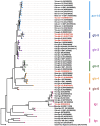This is a preprint.
Transcriptional responses to in vitro macrocyclic lactone exposure in Toxocara canis larvae using RNA-seq
- PMID: 39763735
- PMCID: PMC11702694
- DOI: 10.1101/2024.12.20.629602
Transcriptional responses to in vitro macrocyclic lactone exposure in Toxocara canis larvae using RNA-seq
Abstract
Toxocara canis, the causative agent of zoonotic toxocariasis in humans, is a parasitic roundworm of canids with a complex lifecycle. While macrocyclic lactones (MLs) are successful at treating adult T. canis infections when used at FDA-approved doses in dogs, they fail to kill somatic third-stage larvae. In this study, we profiled the transcriptome of third-stage larvae derived from larvated eggs and treated in vitro with 10 μM of the MLs - ivermectin and moxidectin with Illumina sequencing. We analyzed transcriptional changes in comparison with untreated control larvae. In ivermectin-treated larvae, we identified 608 differentially expressed genes (DEGs), of which 453 were upregulated and 155 were downregulated. In moxidectin-treated larvae, we identified 1,413 DEGs, of which 902 were upregulated and 511 were downregulated. Notably, many DEGs were involved in critical biological processes and pathways including transcriptional regulation, energy metabolism, neuronal structure and function, physiological processes such as reproduction, excretory/secretory molecule production, host-parasite response mechanisms, and parasite elimination. We also assessed the expression of known ML targets and transporters, including glutamate-gated chloride channels (GluCls), and ATP-binding cassette (ABC) transporters, subfamily B, with a particular focus on P-glycoproteins (P-gps). We present gene names for previously uncharacterized T. canis GluCl genes using phylogenetic analysis of nematode orthologs to provide uniform gene nomenclature. Our study revealed that the expression of Tca-glc-3 and six ABCB genes, particularly four P-gps, were significantly altered in response to ML treatment. Compared to controls, Tca-glc-3, Tca-Pgp-11.2, and Tca-Pgp-13.2 were downregulated in ivermectin-treated larvae, while Tca-abcb1, Tca-abcb7, Tca-Pgp-11.2, and Tca-Pgp-13.2 were downregulated in moxidectin-treated larvae. Conversely, Tca-abcb9.1 and Tca-Pgp-11.3 were upregulated in moxidectin-treated larvae. These findings suggest that MLs broadly impact transcriptional regulation in T. canis larvae.
Keywords: ATP-Binding Cassette Transporters; Dogs; RNA-Seq; Toxocara canis; Toxocariasis; glutamate-gated chloride channels; ivermectin; mRNA; moxidectin; transcriptome.
Figures







Similar articles
-
Repertoire of P-glycoprotein drug transporters in the zoonotic nematode Toxocara canis.Sci Rep. 2023 Mar 27;13(1):4971. doi: 10.1038/s41598-023-31556-1. Sci Rep. 2023. PMID: 36973306 Free PMC article.
-
Characterization of a P-glycoprotein drug transporter from Toxocara canis with a novel pharmacological profile.Int J Parasitol Drugs Drug Resist. 2021 Dec;17:191-203. doi: 10.1016/j.ijpddr.2021.10.002. Epub 2021 Oct 23. Int J Parasitol Drugs Drug Resist. 2021. PMID: 34753107 Free PMC article.
-
Differences in constitutive gene expression of cytochrome P450 enzymes and ATP-binding cassette transporter gene expression between a susceptible and a highly macrocyclic lactone-resistant Haemonchus contortus isolate in the absence of drug-inducible expression.Parasit Vectors. 2024 Dec 12;17(1):505. doi: 10.1186/s13071-024-06568-z. Parasit Vectors. 2024. PMID: 39668355 Free PMC article.
-
The epidemiology and public health importance of toxocariasis: a zoonosis of global importance.Int J Parasitol. 2013 Nov;43(12-13):999-1008. doi: 10.1016/j.ijpara.2013.07.004. Epub 2013 Aug 14. Int J Parasitol. 2013. PMID: 23954435 Review.
-
Potential roles of Toxocara canis larval excretory secretory molecules in immunomodulation and immune evasion.Acta Trop. 2023 Feb;238:106784. doi: 10.1016/j.actatropica.2022.106784. Epub 2022 Dec 9. Acta Trop. 2023. PMID: 36502886 Review.
References
Publication types
Grants and funding
LinkOut - more resources
Full Text Sources
Miscellaneous
